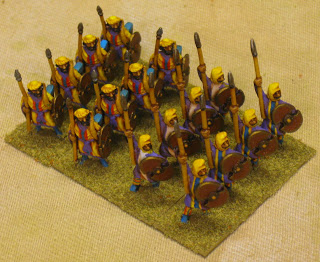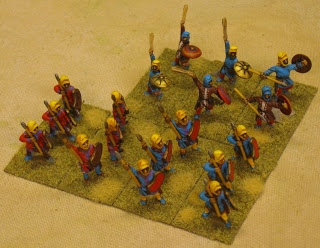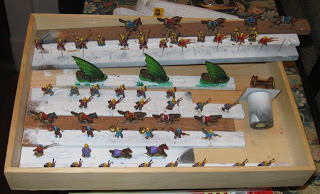The short version of my discussion about realism in wargames is: “There isn’t any.” That may not be entirely true, but it’s a pretty good approximation. This doesn’t stop people from trying to make wargames realistic, though.
When I use the word “realism” I include “verisimilitude,” by which I mean the degree of similarity to fictitious works (even though I now see that may not be exactly what verisimilitude means). Wargames attempting to recreate the War of the Ring or the Battle of the Five Armies can get it just as right or wrong as recreations of the Battle of Thermopylae or the Battle of the Bulge. On the other hand, by “wargame” I’m only referring to board games and miniature games, not video games.
The idea of making a game realistic treats the game as a simulation. But a simulation of what? Different game designers emphasize correctness and realism in different areas, while accepting a greater degree of abstraction in other areas. This can result in very different gameplay for different games.
The most visible kind of realism is in the way the game pieces look. Eurogames and board game wargames typically use very abstract pieces: wooden cubes or square cardboard counters. Ameritrash games emphasize the look of the game and usually include molded plastic figures to represent troops. Using pieces which look realistic is the main reason to play a miniatures game instead of a board game.
The way game pieces look doesn’t need to affect the way the game plays, even though sometimes it does. The visual differences define broad categories of games because they’re the first thing you see. To me, the more interesting difference is the way gameplay changes depending on how a game attempts to achieve realism.
Some wargames are described as “reductionist.” An army is reduced to a specific number of individual men and the machines and equipment they are using. Statistics are collected about the real life performance of these men and their equipment. The game defines strict time scales per turn and well-defined distances on the playing area. The hope is that if you introduce enough detail into the rules, accurate results of the battles they model will emerge (nevermind that whole die-rolling thing…).
I read a good statement of my main criticism of the reductionist school of game design: it confuses “detail” with “realism.” Fine details seem to provide justification for the results the game produces, but they also obscure areas where abstractions have been made, and hide the ways in which the game is unrealistic.
Some common flaws with reductionist games are:
- they require fiddly rules with special cases for all details the game attempts to model
- games are slow or take too long
- rule complexity and slow gameplay cause the game to lose the “feel” of the activity it’s attempting to simulate
- too much bookkeeping
- complex rules can shifr game play emphasis from using period-appropriate tactics to taking advantage of “flaws” in the rules in order to win
As an example of reductionism and its limitations: it is possible to calculate all aspects of the velocity, orientation, and position of an airplane in flight, and to track changes in these over a series of steps in time (game turns) in reactions to the actions of players. However, doing this typically does not feel like flying an airplane: it feels like completing a physics problem set. That’s not my idea of fun.
I know I said I wasn’t talking about video games, but reductionism is something computers can do a lot better than humans. Bookkeeping is not a problem for computers, calculations can be done much more quickly, and no player needs to remember the rules.
Details are not bad by themselves. The important aspect is matching the level of detail with the scale of the game. In a World War II skirmish with 10 guys on each side, it’s important exactly how many men there are, what kind of guns they’re using, and how many bullets they have left. If you’re wargaming the entire European Theater of Operations, these minutae are not only less important to the general commanding the entire army, they aren’t available to him whether he’s interested or not. Learn to delegate.
Other games push detail into a secondary role, and instead emphasize making the game “feel” right for the player, in the context of the role they are playing in the game. In a WWII air combat game, the emphasis might be on making it feel like fast-paced combat where you must react quickly to avoid being shot down. An infantry skirmish might put you in the role of a platoon leader, where you have a few dozen scared kids with guns who would rather hide behind a tree than advance on the enemy machine gun net. Playing General Montgomery attempting to push a long line of troops and tanks down the road in Operation Market Garden is going to be a lot more about logistics and attrition than individual firefights.
Some benefits and optimizations that can be more easily achieved when you emphasize a realistic “feel” while omitting detail are:
- Fewer rules
- Less bookkeeping to do during the game
- Faster gameplay; this is often necessary for a game to feel right
- It’s easier to encourage use of appropriate tactics instead of “gaming” the rules
It has been observed that in the last decade or so wargames have been trending towards cleaner, simpler rulesets instead of the lumbering behemoths of yesteryear. The old guard laments the lack of attention span of “those kids today” and might blame video games for what they perceive as reduced quality in rulesets.
I also invoke video games as a possible reason for this change, but I credit them instead of blaming them. Computers are much more able to reach the logical extreme of reductionist rulesets than humans are. Anyone interested in pursuing extreme detail is generally better off teaching a computer how to follow the rules than a human, and so those game designers with this propensity are creating video games instead of board games. I have no problem with that.
As for how these theoretical preferences affect the games I play in reality…
I enjoy playing video games, becuase they often combine an extreme degree of detail with the “feel” I’m looking for in a game. But of course, I still enjoy a good face-to-face board game or miniature game. I have limited time, so I tend to choose relatively short games, but I don’t often let rule complexity be a limiting factor. I’ve enjoyed playing all kinds of wargames: some more reductionist, and others which emphasize the gameplay instead of the detail. So maybe I’m just in another phase where I don’t like the idea of reductionism?
I also like reading game rules, sometimes without ever playing the game or even owning enough parts to play it. I like to see how designers translate real-world situations into playable game mechanics. These rulesets are solutions to problems of modelling, and it is interesting to me to see the different ways they create abstractions of reality. (In contrast, pure abstract strategy games aren’t interesting to me. One reason for this is becuase the rules exist in a vacuum: they are abstract, but they aren’t an abstract representation of anything.)
Regarding the realism of the way a game looks on the table: I run the gamut in this area as well. I play euro style wargames, ameritrash, and hex and counter games, but right now I’m on a miniatures gaming kick. For me, miniatures games are as much about the modelling as the playing: the prospect of playing a game is an excuse to paint the figures.
Another unintended side effect of the visual detail in a miniatures game is that I am encouraged to learn about the period I’m gaming. Some of this is required to accurately paint figures or plan and set up for a specific battle in history; but some of it is accidental, when I get sucked into books I’m reading on related subjects.
So, don’t fool yourself into thinking any of these games are realistic, but do have fun trying!










